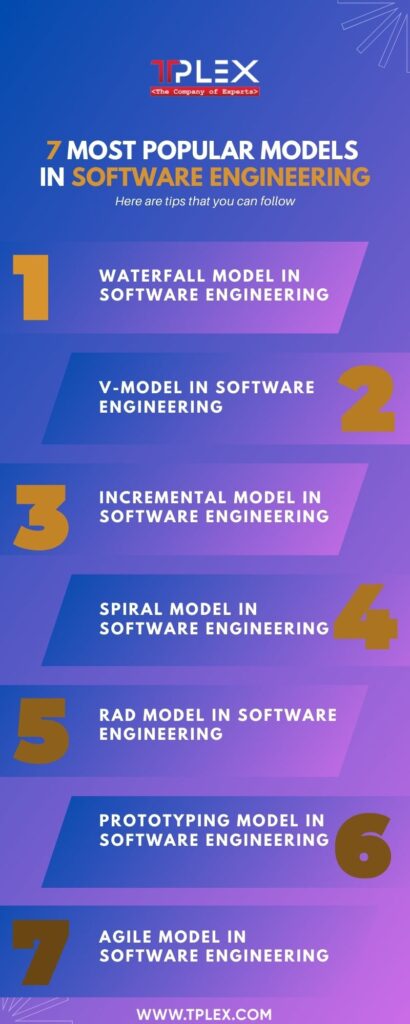7 Most Popular Models in Software Engineering

Creating high-quality software is integral in today’s world. This field is designed with several models allowing developers to build high-quality software. These models allow managers to navigate the complexities of software development, ensuring that projects are completed on time and that they meet user requirements correctly.
In this blog, learn all about the most popular models in software engineering and how they can help.

- Waterfall Model in Software Engineering
This is one of the most famous models in software engineering. Not only that, but it is also the one that is most widely used due to its simplistic nature. Its name comes from the idea of a waterfall flowing. In the same way, this model suggests that once one phase is complete, they can only move on to the next phase. The phases start from the requirement phase and then go on to the design phase, the implementation phase, the verification phase, and then the maintenance phase.
The best part about this model is that it is very simple to understand and, thus, very easily manageable. Due to its simplistic nature, the end goal is determined very early, and this also gives a very structured way of doing things. For large and complex projects, however, this model is not very suitable.
- V-Model in Software Engineering
This is also one of the models in software engineering that is very widely used. This SDLC paradigm is often referred to as the Verification and Validation paradigm. A disciplined model that is often used in the software development process is the V-Model. The V-Model executes each step in sequential order, so a new phase doesn’t start until the previous one is finished. It is based on how each development phase and the testing phase relate to one another in a V-shape and V-model; in other words, software development and testing activities happen at the same time.
This model gets its name from the way that all the phases are connected to each other. This model is also very simple and easy to understand. Phase-by-phase development and testing keep happening and any defects are detected very early on. Again, this model is not highly suitable for complex projects, and there is always a certain level of risk and uncertainty involved.
- Incremental Model in Software Engineering
Amongst software engineering models, this is also a really great one. In this one, the process is divided into several increments, and the phases follow those very increments. There are several phases of the incremental model the communication phase, planning, modeling, construction and deployment. This model is very flexible and, hence, is one that is loved by many. It is also not expensive to change the requirements and the scope.
- Spiral Model in Software Engineering
Combining the methodical elements of the Waterfall Model with iterative development (prototyping), the Spiral Model is a risk-driven process model. It is particularly helpful for big, intricate, and risky projects. The phases of this model include panning, risk analysis, engineering, and evaluation. The main advantage of this model is that it focuses on risk assessment and mitigation. It also allows for iterative refinement through many cycles. However, this one can be more expensive and also takes up more time than the other models. Apart from that, this requires great expertise in risk management.
Related Article: Software Development Outsourcing: A Complete Guide
- RAD Model in Software Engineering
An outgrowth of the incremental methodology, the rapid application development model, or RAD software development paradigm, essentially works on the components separately and individually. When completed, these will be assembled to produce the operational prototype. Imagine doing it like you were assembling the parts of a jigsaw puzzle and then assembling the entire thing once all the pieces are in place. This model is perfect for when you are trying to create samples to show customers something that they will then be able to comment on. There are several phases of this model, which include business modeling, data modeling, process modeling, application generation, and testing and turnover.
- Prototyping Model in Software Engineering
This model is one where the idea is to create a prototype in working conditions. This can then be given to customers so that they can give their feedback as required. The process for this one is that a working sample is first needed to start. Then, after that, that is used to improve the prototype slowly and gradually. However, the downside here is that the final turnout is highly dependent on what other people are saying.
- Agile Model in Software Engineering
This model is a combination of the iterative and the incremental models. The focus here is process adaptability and customer satisfaction. This model was created mainly so that changes to software development can be made in the best way possible, which again made this one of the most popular models in software engineering. The many different models that are used in this one are Scrum, Crystal methods, DSDM, and lean software development. The biggest advantage of this model is that the project can duly be completed in a very short period of time.
How Can TPLEX Help?
At TPLEX, we have several experts in the field of software engineering. So, if you are confused about any aspect of models in software engineering, you can get in touch instantly, and we will have someone guide you through the process. With knowledge of the different types of software engineering models, you will be able to get done with things in a much better way. Trust TPLEX with the process, and you will definitely be happy with the end results. Get in touch today!



